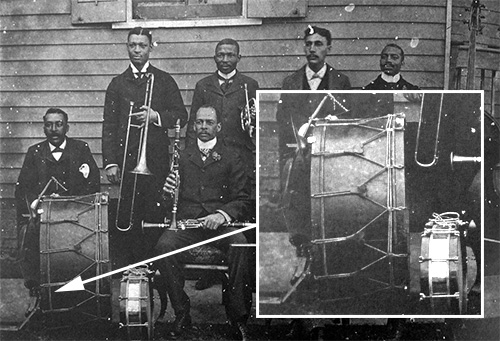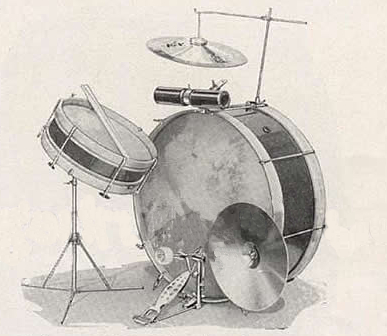Who Invented the Drum Set?
Written by Gunnar Kristiansen on February 12th 2019, updated on March 16th 2023.
This is a question without a definitive answer. It was no single person who invented the drumset but rather a bunch of cultural coincidences in combination with practical and economic considerations.
But let us take a step back in order to better understand where the drum set has its origins.
Before the Drumset
Before the drum set appeared as an instrument in its own right, the spearate parts were played by individual musicians. Here, it is important to understand that they did not play rock or disco music. There styles simply did not exist at this time. Instead, they played military and parade music where one person played the bass drum, one person played the snare drum, and one person played the cymbals - just like we know from march bands.
If you look at the drum set, it is a concoction of instruments from the entire world. Bass drums and snare drums came from the military of European countries and later made it to the American military. Chinese immigrants brought colorfully decorated tom-toms to the USA. These were originally used for traditional Chinese theater. Cymbals evolved from small bronce castings made in Turkey and China. Later, these were hammered more flat and used for both classical music and in the military.
The Drum Set Is Born
In the early 20th century, New Orleans was a melting pot for all these cultures. It was a time where there was a growing demand for new sounds from percussionists, a time where there was not much room on the stage, and a time where money for musicians was tight. Therefore, bandleaders had to economize. Because of this, it made sense if you could get one person to play what earlier took four persons.
At the time, drums played a larger role in the soundtrack of theater shows. Not solely as a rhytmical foundation or an emphasis of this but also for sound effects, soundscapes, accenting jokes, and more. The need for being able to adapt to the scene you played on arose so that there was room for everything. Therefore, the drum set started taking shape. The same did jazz music and you might say that these two helped grow each other in this time period.
But merging numerous rhytmical instruments into one single instrument was not solely a practical measure.
The Drum Set Had a Major Musical Impact
It had a major musical impact that the rhytmic elements all came from one single person. For the first time ever, the music's rhytmical backbone came from one single individual - the drummer. This is the first time we can talk about a rhytmic anchor or center in the band and this had an enormous impact on the evolution of the rhytmical music.
Who invented the drumset - really?
It is difficult to identify a single drummer as the defining figure in relation to the invention of the drum kit, as the development of the drum kit has been a gradual process, with many different musicians and inventors contributing ideas and innovations over time.
However, if we are to talk about individuals, the first name that comes to mind is Edward "Dee Dee" Chandler, who was active in the early years of jazz.
The bass drum pedal

In 1894, jazz drummer Edward Chandler invented the first example of a bass drum pedal. This pedal was made of wood and made it possible to play both bass drum and snare drum simultaneously - by one person.
It was not a bass drum pedal as we know them today, but a hanging mallet that could be operated via the pedal. This new way of playing drums was called "double drumming" in New Orleans.
Edward Chandler's wooden pedal leads us to 1908, when William F. Ludwig's brother-in-law saw a market for mass production of bass drum pedals. In 1909, the Ludwig & Ludwig company was established to meet this demand, with what would later prove to define the bass drum pedal as a product. In other words, the bass drum pedal as we know it today was born.
The Hihat
At this time, the hi-hat had not yet been invented. In fact, it was not until 1931 that we first heard of such an invention. Before this time, the pulse was marked with press rolls on the snare drum, and open/close rhythms were played on splash cymbals using both hands.
The first "real" hi-hat with a built-in spring - also known as a "low-boy" - was sold as a new hip addition to the otherwise known bass drum/snare drum setup of that time. This low-boy was placed just below the snare drum, and the spring allowed for the rhythmic open/close pattern that had been played on a splash cymbal with both hands to be mimicked with just one hand (and foot).
The Drum Set Today
From here, the drum set has evolved over the years into what we now consider a "standard drum set." This includes a bass drum, a snare drum, 1-2 tom-toms, a floor tom, a hi-hat, a ride cymbal, and a crash cymbal.
Throughout the years, both music and individual drummers have played a role in shaping and defining the drum set. Trends have influenced the drum set, just as different genres have called for their specific needs. For example, the concert toms without bottom heads in the 70s, or the deeper power toms in the 80s big pop/rock sound universe.
Today, we continue to see the evolution of the drum set. There is ongoing experimentation with new drum set configurations, as well as new sounds and tones. This will likely continue in the endless pursuit of new inspiration for making music.

